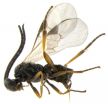(Press-News.org) An innovative workflow reveals new research potential of the Barcode of Life Data Systems (BOLD). A recently published article in the Biodiversity Data Journal (BDJ) used specimen records downloaded from BOLD in tabular format and imported these into a human-readable text developed in manuscript within the Pensoft Writting Tool (PWT). Data were used to study the species distributions of ten Nearctic species of braconid wasps from the Microgastrinae subfamily.
BOLD is originally designed to support the generation and application of DNA barcode data. However, the repository also holds unexplored treasures of additional data that provide unique potential for many other research uses.
Currently almost 4 million sequences (over 3.4 million of them DNA barcodes) are stored in BOLD, including coverage for more than 143K animal species, 53K plant species, and 16K fungi and other species, and this impressive storage of information is continuing to grow every day.
A team of researchers, led by Dr Jose Fernandez-Triana from the University of Guelph, Canada, have now explored how the unique amount of data stored on the BOLD platform can be utilised for new research purposes. Choosing tiny parasitic wasps for their case study they selected a sample of 630 specimens and 10 North American species. Data stored on BOLD were then used to uncover a significant number of new records of locality, provinces, territories and states.
The research was then secured a fast publication via BDJ, a community peer-reviewed, open-access, comprehensive online platform, designed to accelerate publishing, dissemination and sharing of biodiversity-related data of any kind.
"Import of structured data into human-readable text is important but it does not represent the whole story. More importantly, the data can be downloaded straight from the article text by anyone for further re-use, or be automatically exported to data aggregators, such as the Global Biodiversity Information Facility (GBIF). In this way, data platforms could get more peer-reviewed content from scholarly publications and scientists will be properly credited for their efforts" said Prof. Lyubomir Penev, founder of Pensoft Publishers.
INFORMATION:
Original Source:
Fernandez-Triana J, Penev L, Ratnasingham S, Smith M, Sones J, Telfer A, deWaard J, Hebert P (2014) Streamlining the use of BOLD specimen data to record species distributions: a case study with ten Nearctic species of Microgastrinae (Hymenoptera: Braconidae). Biodiversity Data Journal 2: e4153. doi: 10.3897/BDJ.2.e4153
Additional information:
The workflow is part of the Data Publishing Toolkit elaborated within the EU FP7 funded project EU BON (Grant agreement No 308454).
Go straight and publish: From Barcode of Life Data Systems to scholarly publishing systems
2014-10-29
ELSE PRESS RELEASES FROM THIS DATE:
Saving lots of computing capacity with a new algorithm
2014-10-29
The control of modern infrastructure such as intelligent power grids needs lots of computing capacity. Scientists of the Interdisciplinary Centre for Security, Reliability and Trust (SnT) at the University of Luxembourg have developed an algorithm that might revolutionise these processes. With their new software the SnT researchers are able to forego the use of considerable amounts of computing capacity, enabling what they call micro mining. Their achievements, which the team headed by Prof. Yves Le Traon published in the International Conference on Software Engineering ...
NYU research: Tourism as a driver of illicit drug use, HIV risk in the DR
2014-10-29
The Caribbean has the second highest global human immunodeficiency virus (HIV) prevalence in the world outside of Sub-Saharan Africa, with HIV/AIDS as leading cause of death among people aged 20–59 years within the region. Particularly hard-hit are the Dominican Republic (DR) and Haiti, on the island of Hispaniola, accounting for approximately 70% of all people living with HIV in the Caribbean region.
Insufficient attention has been paid to the intersection of drugs and tourism as contributing factors for the region's elevated HIV/AIDS risk. Caribbean studies ...
Prenatal phthalate exposures and anogenital distance in Swedish boys
2014-10-29
The first study to examine prenatal exposure to the phthalate DiNP finds it is associated with a shorter anogenital distance (AGD) in Swedish boys at the age of 21 months. These findings raise concern since animal research has linked DiNP exposure to a shorter AGD, and studies on humans have related shorter AGD to male genital birth defects as well as impaired reproductive function in adult males, and the levels of DiNP metabolites in humans are increasing globally.
Background
Phthalates are used as plasticizers in soft polyvinyl chloride (PVC) and found in a large ...
Largest ever dataset of individual deaths in Africa & SE Asia reveals changing health
2014-10-29
More than 110,000 individual deaths and their causes across 13 countries, including Ghana, South Africa, Kenya, Bangladesh and Vietnam, are contained in the new INDEPTH dataset. The data, collected by hundreds of researchers over two decades, are the first meaningful community-based information about cause of death in countries where individual deaths are not recorded automatically by national governments.
The INDEPTH cause of death findings are published in a special issue of the journal Global Health Action, which is fully open access. There are six multisite papers ...
Aortic valve replacement appears safe, effective in very elderly patients
2014-10-29
Chicago, October 29, 2014 – Aortic valve replacement (AVR) can safely be used to treat severe aortic stenosis in patients age 90 years and older and is associated with a low risk of operative stroke and mortality, according to a study in the November 2014 issue of The Annals of Thoracic Surgery.
Key points
Aortic valve replacement appears to be safe and effective for patients over age 90 years with severe aortic stenosis.
Four out of five (81.3%) patients were alive 1 year following AVR.
TAVR had similar rates of morbidity and mortality as traditional surgical ...
Support for fecal testing in familial colorectal cancer screening
2014-10-29
Bethesda, MD (Oct. 29, 2014) — Fecal immunochemical tests (FIT) may be as effective as colonoscopies when it comes to detecting colorectal cancer among first-degree relatives of patients with colorectal cancer, according to a new study in Gastroenterology1, the official journal of the American Gastroenterological Association.
"In our study, repeat FIT screening detected all colorectal cancers in asymptomatic first-degree relatives of patients with colorectal cancer," said lead study authors Enrique Quintero, MD, PhD, and Marta Carrillo, MD, from Hospital Universitario ...
Georgia Tech releases 2015 Emerging Cyber Threats Report
2014-10-29
In its latest Emerging Cyber Threats Report, Georgia Tech warns about loss of privacy; abuse of trust between users and machines; attacks against the mobile ecosystem; rogue insiders; and the increasing involvement of cyberspace in nation-state conflicts.
Such topics are discussed at length in the annual report, which is published by the Georgia Tech Information Security Center (GTISC) and the Georgia Tech Research Institute (GTRI). The report will be released this week at the 12th Georgia Tech Cyber Security Summit (GT CSS), which has become the Atlanta IT community's ...
New technology shows promise for delivery of therapeutics to the brain
2014-10-29
A new technology that may assist in the treatment of brain cancer and other neurological diseases is the subject of an article in a recent issue of the journal Technology, published by World Scientific Publishing Company.
According to the authors, the current medical use of chemotherapy to treat brain cancer can be inefficient because of the blood-brain-barrier that impedes the delivery of drugs out of blood vessels and into the tumor.
The researchers from the Virginia Tech – Wake Forest University School of Biomedical Engineering and Sciences described in their ...
Smoke and haze over China
2014-10-29
Smoke and haze hang over a large portion of eastern China in this image captured by the Aqua satellite on October 29, 2014. China uses the method of "slash and burn" agriculture to rid their fields of leftover plants. Farmers often use fire to return nutrients to the soil and to clear the ground of unwanted plants. While fire helps enhance crops and grasses for pasture, the fires also produce smoke that degrades air quality as seen in this image.
The U.S. Consulate in Beijing records an air quality index of 226 for October 29 putting it in the "Very Unhealthy" region. ...
Microrockets fueled by water neutralize chemical and biological warfare agents
2014-10-29
With fears growing over chemical and biological weapons falling into the wrong hands, scientists are developing microrockets to fight back against these dangerous agents, should the need arise. In the journal ACS Nano, they describe new spherical micromotors that rapidly neutralize chemical and biological agents and use water as fuel.
Joseph Wang and colleagues point out that titanium dioxide is one of the most promising materials available for degrading chemical and biological warfare agents. It doesn't require harsh chemicals or result in toxic by-products. Current ...




